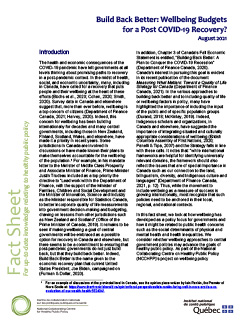Build Back Better: Wellbeing Budgets for a Post COVID-19 Recovery?
The health and economic consequences of the COVID-19 pandemic have left governments at all levels thinking about promising paths to recovery in a post-pandemic context. In the midst of health, social, and economic uncertainty, many, including in Canada, have called for a recovery that puts people and their wellbeing at the heart of these efforts (Büchs et al., 2020; Cohen, 2020; Smith, 2020). Survey data in Canada and elsewhere suggest that, more than ever before, wellbeing is a top concern of citizens (Department of Finance Canada, 2021; Harvey, 2020). Indeed, this concern for wellbeing has been building internationally for decades and many central governments, including those in New Zealand, Finland, Scotland, Wales, and elsewhere, have made it a priority in recent years. Some jurisdictions in Canada are involved in discussions or have made known their plans to make themselves accountable for the wellbeing of the population. For example, in his mandate letter to the Minister of Middle Class Prosperity and Associate Minister of Finance, Prime Minister Justin Trudeau included as a top priority the directive to “Lead work within the Department of Finance, with the support of the Minister of Families, Children and Social Development and the Minister of Innovation, Science and Industry as the Minister responsible for Statistics Canada, to better incorporate quality of life measurements into government decision-making and budgeting, drawing on lessons from other jurisdictions such as New Zealand and Scotland” (Office of the Prime Minister of Canada, 2019). It remains to be seen if making wellbeing a goal of central governments will be embraced as a possible option for recovery in Canada and elsewhere, but there seems to be a commitment to ensuring that post-pandemic governments do not just build back, but that they build back better. Indeed, Build Back Better is the name given to the economic recovery plan that current United States President, Joe Biden, campaigned on (Furman & Dollar, 2020).
In addition, Chapter 3 of Canada’s Fall Economic Statement is entitled, “Building Back Better: A Plan to Conquer the COVID-19 Recession” (Department of Finance Canada, 2020). Canada’s interest in pursuing this goal is evident in its recent publication of the document Measuring What Matters: Toward a Quality of Life Strategy for Canada (Department of Finance Canada, 2021). In the various approaches to building back better and to including quality of life or wellbeing factors in policy, many have highlighted the importance of including the input of the public and of specific population groups (Durand, 2018; McKinlay, 2019). Indeed, Indigenous scholars and organizations, in Canada and elsewhere, have suggested the importance of integrating situated and culturally appropriate considerations of wellbeing (British Columbia Assembly of First Nations, 2020; Panelli & Tipa, 2007) and the Strategy falls in line with these calls. It notes that: “while international frameworks are helpful for identifying universally relevant domains, the framework should also reflect the issues that are of special importance in Canada such as our connection to the land, bilingualism, diversity, and Indigenous culture and languages” (Department of Finance Canada, 2021, p. 12). Thus, while the movement to include wellbeing as a measure of success is growing internationally, most recognize that such policies need to be anchored in their local, regional, and national contexts.
In this fact sheet, we look at how wellbeing has developed as a policy focus for governments and how it might be related to public health concerns such as the social determinants of physical and mental health and health inequalities. We consider whether wellbeing approaches to central government policies may advance the goals of healthy public policy. As part of the National Collaborating Centre on Healthy Public Policy (NCCHPP)’s project on wellbeing policy approaches and wellbeing budgeting, we outline here what wellbeing budgeting is and its promise in the wake of the COVID-19 pandemic in Canada.


